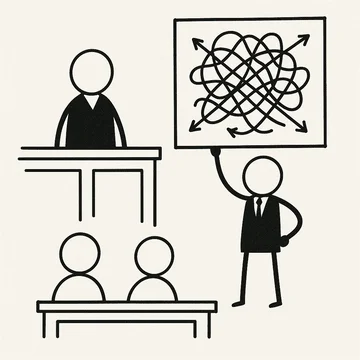The Court has said in the past that "winning summary judgment in a patent case is like hitting a hole in one." Well, yesterday DePuy Synthes scored a hole in one, invalidating all asserted claims of one patent on SJ in RSB Spine, LLC v. DePuy Synthes Sales, Inc., C.A. No. 19-1515-RGA (D. Del. Nov. 22, 2022).
How Did They Do It?
Basically, they won it at claim construction, but couldn't end the case until summary judgment.
The patent at issue, U.S. Patent No. 6,984,234, covers a "base plate" that a surgeon can screw into two bones in a person's spinal cord to stabilize them.
The base plate screws into the bones (blue, below), and a bone graft sits in between them (yellow, below), to stabilize the two bones:

D.I. 181 at 3.
The prior art patent, U.S. Patent Publication No. 2002/0099376, disclosed a different bone stabilization structure, a spinal implant that screwed into two vertebrae:

The accused infringer argued in its brief that the blue part of the prior art, below, was the claimed "base plate" of the asserted patent:

D.I. 181 at 5. The rest of it, in white, is a "spacer." Id. at 15-16.
The motion worked well here because the parties agreed that the prior art met every other element of the asserted claims:
The parties agree there is only a single disputed issue in this anticipation analysis: whether Michelson 376 discloses a “base plate.” . . . Every other claim element is disclosed in Michelson 376. Consequently, resolving this motion for summary judgment boils down to determining whether or not, making all inferences in Plaintiff’s favor, a reasonable jury could find that Michelson 376 does not disclose a base plate.
To resolve the motion, the Court mainly had to address a claim construction issue: whether its construction of "base plate" encompassed the blue part of the prior art, above—even if that blue part is connected to the "spacer" that forms the rest of the prior art device:
I rule for Defendants because, in light of my claim construction, I find that no reasonable jury could conclude that Michelson 376 does not disclose a base plate. . . . Plaintiff argued during claim construction that a “base plate” needed to be “distinct” from a spacer. (D.I. 123 at 8). I rejected this requirement, particularly because Plaintiff indicated that the “base plate” and spacer could both be made of bone graft material. Id.
To try to escape summary judgment, the plaintiff argued that the blue part above is not a "plate" because it's not called that in the prior art itself. That didn't get them anywhere:
Plaintiff first looks to Michelson 376, arguing that the trailing end is not a plate because Michelson 376 does not refer to it as a plate, even though Michelson referred to other structures as plates in other publications. (D.I. 188 at 8). This argument misses the point. Defendants correctly note that anticipation “is not an ‘ipssimis verbis’ test.” In re Bond, 910 F.2d 831, 832 (Fed. Cir. 1990). The fact that Michelson 376 does not use the word “plate” does not carry any weight in this analysis.
The plaintiff also argued that the blue highlights are arbitrary—but the Court pointed out that it gets an identification number and a name in the prior art:
Plaintiff criticizes Defendants’ expert for identifying an “arbitrarily subdivided portion of a monolithic structure to be a ‘base plate.’” . . . Yet, the portion of the object in question—the “trailing end”—is identified and discussed in Michelson 376 itself. (D.I. 169 Ex. 1 ¶¶ 40-41(“Trailing end 104 includes bone screw receiving holes . . .”)). Reference number 104 can be seen in Figure 1 . . . as well as other figures in the patent. . . . I do not think a reasonable jury could find such a subdivision to be arbitrary. It is also worth noting that accepting Defendants’ subdivision does not imply that “a ‘portion’ of any three-dimensional object could be a ‘plate,’ if sliced the right way by imaginary lines.” . . . Pointing to a portion of an object recognized and identified by its inventor is different from slicing that object with imaginary lines.
The Court also rejected an argument by the patentee's expert that the plate must be a "distinct component or structure," since the plaintiff also conceded that it could be "indistinct from a spacer."
In sum, the parties only disputed one claim element, and the dispute on that element was mostly a claim construction issue that the Court had already resolved in the moving party's favor. Those are the kind of ideal conditions that make SJ of invalidity more readily achievable. But, even so, I'm sure the good briefing and clear analysis by the accused infringer helped a lot!
Side Note: Figures Are Awesome! But . . .
I'm a big proponent of figures in patent briefs, especially if you are talking about anything physical or mechanical. It just makes everything so much clearer and easier to grasp. You really can't beat a diagram or figure for explaining complex material.
But they have some downsides.
Too Much Space
The biggest is how much space they can take up. Honestly, they are best used in briefs before those of our judges who permit the use of word limits rather than page limits.
I've seen it time and again: when the brief has a page limit, the first draft has large graphics that clearly explain exactly the argument we are making. But each time the draft is revised, the figures get cut or made smaller, until the final draft is left with one lingering postage-stamp-sized figure that is barely legible.
I'm hoping that the Court's new advisory committee recommends an optional word limit rather than a page limit, which will help with this problem.
Use This One Weird Trick to Avoid Counter-Arguments
The other big downside is that figures can be too precise. That nearly happened here. The patentee accused the defendant of drawing arbitrary lines—and they were right! The blue highlights above are arbitrary.
Luckily for the defendant, the Court sidestepped that issue by omitting the blue-highlighted figure from the opinion, and instead relied on the prior art's own "104" numbering.
In fact, the Court hit on a solution I've seen in plenty of briefs: For mechanical figures, just use arrows instead of highlighting. Here is the figure the Court put in its opinion:

The Court's arrow points to the "104" designation, but it could just as easily have pointed to the "base plate" itself.
When you use an arrow rather than something like the precise blue highlighting the defendant used, you can get a lot of clarity for the reader without tying yourself down. The arrow's lack of precision can actually be an advantage, in that it makes your figures harder for the other side to respond to or question.
If you enjoyed this post, consider subscribing to receive free e-mail updates about new posts.





